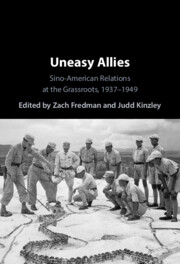Book contents
- Uneasy Allies
- Uneasy Allies
- Copyright page
- Contents
- Figures
- Contributors
- Acknowledgments
- Maps
- 1 Introduction
- Part I An Informal Alliance
- Part II Entanglements of American Empire
- Part III American Power and the New World Order
- Part IV The New Imperialism
- 10 Haydon Boatner and Sino-American Military Cooperation
- 11 Dealing with the Dead in the China-Burma-India Theater
- 12 Qingdao and the Politics of Occupation in Postwar China
- 13 The Debate over ‘Jeep Girls’ in Postwar China
- 14 Smuggling, Military Jurisdiction, and the Remaking of US Empire in Postwar China
- 15 Conclusion
- Bibliography
- Index
12 - Qingdao and the Politics of Occupation in Postwar China
from Part IV - The New Imperialism
Published online by Cambridge University Press: 12 December 2024
- Uneasy Allies
- Uneasy Allies
- Copyright page
- Contents
- Figures
- Contributors
- Acknowledgments
- Maps
- 1 Introduction
- Part I An Informal Alliance
- Part II Entanglements of American Empire
- Part III American Power and the New World Order
- Part IV The New Imperialism
- 10 Haydon Boatner and Sino-American Military Cooperation
- 11 Dealing with the Dead in the China-Burma-India Theater
- 12 Qingdao and the Politics of Occupation in Postwar China
- 13 The Debate over ‘Jeep Girls’ in Postwar China
- 14 Smuggling, Military Jurisdiction, and the Remaking of US Empire in Postwar China
- 15 Conclusion
- Bibliography
- Index
Summary
In October 1945, the US Marines landed in Qingdao and occupied this former German colony in coastal China until May 1949. During this time, the Marines and the US Seventh Fleet turned Qingdao into another base town in postwar China, and interactions between American military personnel and Chinese civilians there were frequent, multifaceted, and often resulted in clashes, tension, and anti-American sentiments among the Chinese population. Focusing specially on engagement between the US Marines and the Chinese students at Shandong University in Qingdao, this chapter weaves the history of student anti-civil war protest in China with the history of American occupation of China after World War II. It argues that incidents such as Shen Chong Rape Incident in Beiping and Su Mingcheng Incident in Qingdao where Chinese civilians were either physically harmed or killed as a result of American military presence in postwar China added a nationalistic and anti-American dimension to student protests, and that the “American factor” in student protest left a lasting but complex impact on the postwar U.S.-China relations.
Keywords
- Type
- Chapter
- Information
- Uneasy AlliesSino-American Relations at the Grassroots, 1937–1949, pp. 215 - 234Publisher: Cambridge University PressPrint publication year: 2024

